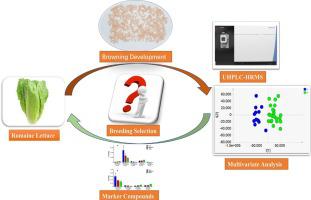Postharvest Biology and Technology ( IF 6.4 ) Pub Date : 2021-06-19 , DOI: 10.1016/j.postharvbio.2021.111626 Zhihao Liu , Jianghao Sun , Zi Teng , Yaguang Luo , Liangli Yu , Ivan Simko , Pei Chen

|
Enzymatic browning negatively impacts product quality and shelf-life of packaged fresh-cut lettuce. Metabolite profiles of lettuce are affected by the browning process. The purpose of this study was to identify metabolomic marker compounds to predict lettuce browning, which could be applied to discern accessions suited for commercial production and industrial breeding programs. Romaine lettuce with different browning susceptibilities were evaluated in two independent trials and growing seasons. Metabolites were analyzed using ultra-high-performance liquid chromatography coupled with high-resolution mass spectrometry (UHPLC-HRMS). Principal component analysis (PCA) was performed to visualize clusters, trends, and discriminative ion features. Seven metabolites, including quinic acid, caffeoylquinic acid, 3-hydroxytetradecanedioic, cichorioside B, 8-deacetylmatricarin-8-sulfate, dicaffeoylquinic acid and 9S,12S,13S-trihydroxy-10Z-octadecenoic acid, increased with storage time (day 0 vs. day 3) Three metabolites, including lactucopicrin-15-oxalate, tri-4-hydroxyphenylacetyl glucoside and 15-deoxylactucin-8-sulfate, decreased with storage time (day 0 vs. day 3). Two additional phenolic metabolites, dicaffeoyltartaric and caffeoyltartaric acids, were identified as potential marker compounds, whose presence on day 0 samples immediately after cutting was negatively correlated with browning development (represented by ΔHue). The identified metabolites help to elucidate the biochemical metabolism and pathways during enzymatic browning and have the potential to serve as marker compounds for predicting browning resistant accessions.
中文翻译:

使用非靶向 UHPLC-HRMS 代谢组学鉴定用于预测鲜切生菜褐变的标记化合物
酶促褐变会对包装好的鲜切生菜的产品质量和保质期产生负面影响。生菜的代谢物谱受到褐变过程的影响。本研究的目的是确定代谢组学标记化合物来预测生菜褐变,这可用于辨别适合商业生产和工业育种计划的种质。在两个独立的试验和生长季节中评估了具有不同褐变敏感性的长叶莴苣。使用超高效液相色谱结合高分辨率质谱 (UHPLC-HRMS) 分析代谢物。执行主成分分析 (PCA) 以可视化集群、趋势和判别离子特征。七种代谢物,包括奎宁酸、咖啡酰奎宁酸、3-羟基十四烷二酸、菊苣甙 B、与第 3 天相比)三种代谢物,包括乳酸苦苷-15-草酸盐、三-4-羟基苯乙酰葡萄糖苷和 15-脱氧乳酸-8-硫酸盐,随着储存时间的增加而减少(第 0天与第 3 天)。两种额外的酚类代谢物,二咖啡酰酒石酸和咖啡酰酒石酸,被鉴定为潜在的标记化合物,其在切割后第 0 天样品中的存在与褐变发展呈负相关(由 ΔHue 表示)。鉴定出的代谢物有助于阐明酶促褐变过程中的生化代谢和途径,并有可能作为预测褐变抗性种质的标记化合物。











































 京公网安备 11010802027423号
京公网安备 11010802027423号